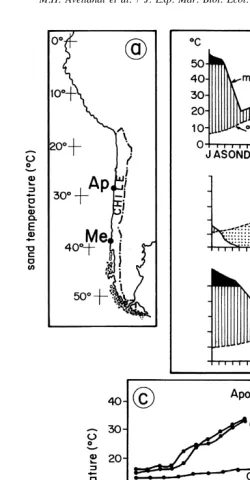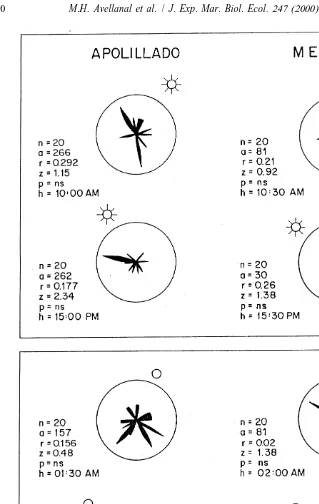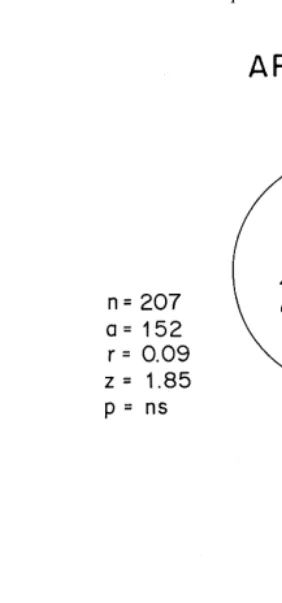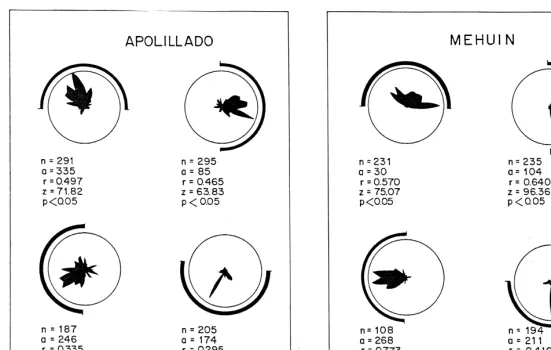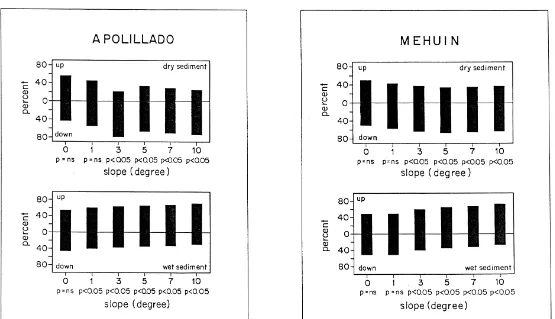L
Journal of Experimental Marine Biology and Ecology 247 (2000) 153–167
www.elsevier.nl / locate / jembe
Orientation of Phalerisida maculata Kulzer (Coleoptera,
Tenebrionidae) in sandy beaches of the Chilean coast
Orientation of Phalerisida maculata in sandy beaches
a a ,* b b
Maria H. Avellanal , Eduardo Jaramillo , Ernest Naylor , Fergus Kennedy
a
´
Instituto de Zoologıa-Universidad Austral de Chile, Casilla 567, Valdivia, Chile
b
School of Ocean Sciences, University of Wales-Bangor, Marine Science Laboratories, Menai Bridge, UK Received 23 March 1999; received in revised form 9 December 1999; accepted 10 December 1999
Abstract
The orientation stimuli of adult individuals of the beetle Phalerisida maculata Kulzer (Coleoptera, Tenebrionidae) over the beach surface, were studied at two sandy beaches of the
chilean coast approximately 1300 km apart, Apolillado (ca. 298 S) and Playa Universitaria de
´
Mehuın (ca. 398S). Phalerisida maculata did not orient by astronomic cues such as the sun and
moon, nor by the terrestrial magnetic field. Both populations showed positive scototaxis, and oriented downward on slopes with dry sediments, and upwards on slopes with wet sediments.
2000 Elsevier Science B.V. All rights reserved.
Keywords: Insecta; Coleoptera; Orientation; Sandy beaches; Chile
1. Introduction
Some coleopteran insects, talitrid amphipods and oniscoidean isopods, are typical organisms which burrow at upper shore levels of sandy beaches (see review by McLachlan and Jaramillo, 1995). When active over the beach surface, they move away from their burrowing zones, to which they return in response to various stimuli which guide the individuals in a direction perpendicular to the coastline (Scapini, 1988; Scapini
*Corresponding author. Tel.: 156-63-22-1649; fax: 156-63-22-1649.
E-mail address: [email protected] (E. Jaramillo)
154 M.H. Avellanal et al. / J. Exp. Mar. Biol. Ecol. 247 (2000) 153 –167
et al., 1992; Scapini and Mezzetti, 1993). Reported stimuli for such orientational behaviour include astronomical cues (sun and moon) for the amphipods Talitrus saltator and Orchestoidea corniculata in sandy beaches of Italy (Papi and Pardi, 1953) and California respectively (Enright, 1961) and for the coleopterans Eurynebria complanata on beaches of the Mediterranean and Atlantic seas (Colombini et al., 1994), and Paederus rubrothoracicus and Stenus bipunctatus on the estuarine beaches of Arno River in Italy (Ercolini and Scapini, 1976). The magnetic cues have been demonstrated on Talitrus saltator from the Tyrrenian and Ligurian seas (Italy) (Scapini and Quochi, 1992). Arendse (1978) also mentioned this cue as important for the orientation of the coleopteran Tenebrio molitor. Scapini et al. (1988) found that direction and intensity of wind as well as different light wavelengths act as positive cues in the orientation of the amphipods Talitrus saltator and Orchestia mediterranea in sandy beaches with different orientation. Landscape has been found to have a significant role in the orientation of different populations of Talitrus saltator from the Mediterranean sea (Ugolini et al., 1986) and British beaches (Williamson, 1951; Edwards and Naylor, 1987); also in Orchestoida corniculata from southern California (Craig, 1973), and in some popula-tions of Eurynebria complanata from the coast of Italy and France (Colombini et al., 1994). Orientation to slope and water content of the sediments has been found in Talitrus saltator from a beach of central Italy (Ercolini and Scapini, 1974), in Orchestoidea corniculata in California (Craig, 1973), on the freshwater amphipod Orchestia cavimana from the Arno River (Scapini and Bartolozzi, 1983) and in the isopod Tylos punctatus from a beach of Baja California (Mexico) (Hamner et al., 1968). It has been also shown that behavioural timing cues may vary according to locality (Naylor, 1989). In the intertidal midge Clunio marinus, for example, low latitude populations utilize moonlight cues, whereas that is not so in populations of the same species in high latitudes where, because of weather conditions, moonlight is an unreliable synchronizer (Neumann, 1978).
Phalerisida maculata Kulzer, 1954, is a tenebrionid coleopteran that lives in the upper shore levels of chilean sandy beaches from about 18 to 418S (Jaramillo, 1987; Jaramillo et al., 1998), where the food of this species consists of algal fragments and other organic
˜
2. Material and methods
2.1. Area description
The study sites were Playa Apolillado (Apolillado hereafter)(298 109 S, 718 299 W)
´ ´
and Playa Universitaria de Mehuın (Mehuın hereafter) (398269S, 738139W) (Fig. 1a), about 1300 km apart. Apolillado is located closely to Martin’s (1923) warm zone where the mean temperature for the warmest month varies from about 15 to 228C, and for the coldest month from 10 to 138C. Brattstrom and Johanssen (1983) state that the annual rainfall increases from about 110 mm at 308S to 760 mm at 378S and still higher further
´
south. According to Brattstrom and Johanssen (1983), Mehuın (ca. 398S) lies within the rainy zone (38–568S) of Martin (1923). The mean annual temperature at the latitude of
´
Mehuın (ca. 398S) is about 12.58C. These climatic characteristics are graphically displayed by Walter’s climatic diagrams (Fig. 1b). In this representation, the abcissa represents the months of the year, while the two ordinate axes represent temperature (8C) and rainfall (mm) (upper graph in Fig. 1b). Aridity (dotted area) is indicated when the curve of rainfall is located below the curve of temperature. With the exception of periods exceeding 100 mm rainfall which are black, humid periods are conventionally represented by vertical lines (di Castri and Hajek, 1976). While, Apolillado is typical of the warm zone delimited by Brattstrom and Johanssen (1983) where the arid period
´
occurs during most of the year, Mehuın is typical of the rainy zone where there is an excess of rainfall during at least half of the year (Fig. 1b). The above description may be supplemented by the analysis of unpublished sand temperature data collected across the intertidal zone of both study sites (Fig. 1c). However, the following comparison must be viewed with caution since the data compared come from different years. Winter data
´
collected during July show little difference between Apolillado and Mehuın (maximum of 138C at the first site versus 11.38C at the second). However, during spring (November), sand temperatures reach higher values at Apolillado (up to 32–338C) than
´
at Mehuın (up to 28.58C). In the present comparison, late summer temperatures (March) ´
were higher at Mehuın.
Unpublished data (Table 1) show that both beaches are quite similar in mor-phodynamic characteristics. According to Dean’s parameter (a measure to categorize
Table 1
Beach face slopes, wave characteristics, mean grain size of sands and Dean’s (V) parameter estimated for each beach (unpublished data source)
´
Apolillado Mehuın
11 / 96 03 / 97 11 / 92 02 / 93
1 / slope 1 / 21 1 / 21 1 / 20 1 / 31
Wave height (cm) 218.0 158.0 300.0 160.0
Wave period (s) 16.0 13.0 13.0 14.0
Mean grain size (mm) 229.0 187.0 300.0 250.0
156 M.H. Avellanal et al. / J. Exp. Mar. Biol. Ecol. 247 (2000) 153 –167
´
Fig. 1. a) Location of Apolillado (Ap) and Mehuın (Me) on the Chilean coast. b) Walter’s climatic diagrams (temperature and rainfall) of two selected coastal localities, La Serena (ca. 308S) and Punta Galera (ca. 408S) closely located to the study sites (figures taken from di Castri and Hajek, 1976). The scales of this representation are shown in the inserted diagram on the upper side of Fig. 1b, c) across shore variability in
´
type of beaches), both beaches can be classified as intermediate (sensu Short and Wright, 1983).
2.2. Collection and maintenance of experimental animals
Experimental individuals were collected by using pitfall traps set in the intertidal zone during the night. For the majority of the experiments, insects were maintained for periods lasting 5–6 days in plastic trays filled with damp sand and kept in a constant temperature room with simulation of the natural photoperiod. These animals were fed ad libitum with the algae Macrocystis pyrifera (Linnaeus) C. Agardh. For some experi-ments (orientation to astronomic cues, see below) the collected animals were used immediately after collection. Each tested animal was used only once; i.e. after only once run the insects were returned to the beach.
2.3. Experiments
Experiments were carried out with adults in response to astronomical cues (sun and moon), earth’s magnetic field, artificial landscape (scototaxis to a black strip), and slope (with differing water contents of substrate).
To evaluate the effect of sun and moon on the direction of P. maculata, 20 beetles were placed individually in a glass arena (26 cm diameter and 8 cm high in the centre), the base of which was divided in 363108 sectors (Craig, 1971) (Fig. 2a). The glass container was placed on a flat surface with total exposure to the sky, and with no objects nearby to create shadows. An opaque cardboard cylinder of 5 cm height was placed around the arena, to eliminate a view of the surrounding landscape. Individual insects were placed at the centre of the container, their position being registered every 5 s until 20 records for each individual were obtained. The experiment was repeated at two different times during the day and night, to determine the direction of orientation in relation to different positions of the sun and moon. These experiments were carried out on the home beach, immediately after collection.
To study the role of the earth’s magnetic field, experiments were carried out in a modified circular arena based upon the design of Scapini and Pardi (1979). The arena had two circular surfaces, one 15 cm above the other, the upper one of 40 cm of diameter and the lower one of 50 cm (Fig. 2b). Adults of P. maculata (about 100 beetles) were placed individually at the centre of the upper surface, over which they could moved freely until reaching the edges. When falling to the lower disk the beetles were caught in one or other of 36 plastic jars (3 cm diameter and 5 cm height) arranged around the periphery. The arena was placed horizontally in a dark room, without sediment on the upper surface, and it was assumed that the only stimulus available for the individual was the earth’s magnetic field, following Arendse (1978). The experiments were carried out at night (00:00–03:00 h.).
158 M.H. Avellanal et al. / J. Exp. Mar. Biol. Ecol. 247 (2000) 153 –167
observed for 15–20 min. The experiments were carried out at night (00:00–03:00 h.) in a dark room with dim red illumination from above.
To test the influence of beach slope with differing sediment water content, on the direction of P. maculata, a wooden corridor was used (2 m length, 10 cm width and 10 cm height) (Fig. 2d). The experiments were carried out in the laboratory under dark conditions. Different slopes, with dry sediment and wet sediments were used. Dry sediments refer to those collected from the zone above the drift line (mean water content: 2–3%, EJ unpublished data), while wet sediments refer to those collected from the middle of the retention zone (mean water content: 10–12%, EJ unpublished data). Fifty individuals were used in each experiment. The numbers of beetles aggregated at each end of the corridor were counted after 45 min, numbers buried or still walking (no more than 10%) being ignored. The experiments were carried out at night (00:00–04:00 h.) in a dark room. Experiments were carried out with slopes of 0, 1, 3, 5, 7 and 108, first with dry sediment in the experimental corridor an then with wet sediment.
2.4. Statistical analysis
Statistical analysis of circular distributions in the arena experiments followed Zar (1996). To test for orientation to the sun and moon, using data from the glass bowl apparatus, the mean angle and vector length for each individual was determined from the 20 recorded directions, then the second order mean angle and vector length was calculated from these data for the all individuals in the experiment, using circular statistical techniques described by Zar (1996). For earth’s magnetic field and scototaxis, the average angle (a) was calculated and the dispersion of the data (r) around this angle (based on the frequency allocation obtained by the Rayleigh test (z)) was used to calculate the probability that the studied population presented a circular uniform
2
distribution. Thex test was used (Siegel, 1956) for analysis of results obtained using the experimental corridor.
3. Results
Fig. 3 illustrates the escape directions of P. maculata in relation to two positions of the sun and moon at each locality studied. In all cases the escape directions were random, indicating no fixed angle orientation to either the sun or the moon, and no time-compensated escape direction irrespective of the positions of the sun and moon.
Fig. 4 presents the pooled escape direction for all P. maculata tested for orientation to the earth’s magnetic field at the two study localities. The results obtained with both beetle populations, exhibit uniform circular distributions (P.0.05), indicating no significant effect of the earth magnetic field on orientation.
Escape directions of P. maculata in response to scototactic cues are illustrated in Fig. 5. Irrespective of the position of the black 1808arc of the cardboard at both localities, the individuals showed a statistically significant scototatic response towards the black boundary in each of its four positions at each locality.
160 M.H. Avellanal et al. / J. Exp. Mar. Biol. Ecol. 247 (2000) 153 –167
´
´
Fig. 4. Testing orientation of P. maculata of Apolillado and Mehuın with respect to the earth’s magnetic field. N, position of the magnetic north; n, number of individuals tested; a, average angle; r, resulting vector; z, Rayleigh’s test; P5ns or P.0.05.
substrates of wet or dry sand (see Materials and methods) are illustrated in Fig. 6. On dry sand, beetles from Apolillado and Mehuin showed no significant orientation on slopes less than 38. However, on steeper slopes, up to the maximum of 108tested, all beetles from both areas moved significantly in a downward direction. In contrast, the opposite was found when wet sediments were used; on slopes equal and greater than 18 (Apolillado) and equal and greater than 38(Mehuin), P. maculata moved significantly in an upward direction.
4. Discussion
The results of this study, show that of the four stimuli tested to evaluate their role in the orientation of P. maculata, only a 1808 black arc (artificial landscape) and slope together with water content of sediments, were effective.
162
M
.H
.
Avellanal
et
al
.
/
J.
Exp
.
Mar
.
Biol
.
Ecol
.
247
(2000
)
153
–
167
´
.H
.
Avellanal
et
al
.
/
J.
Exp
.
Mar
.
Biol
.
Ecol
.
247
(2000
)
153
–
167
163
´
Fig. 6. Testing orientation of adults of P. maculata of Apolillado and Mehuın with respect to slope and water content of the sediment. The experimental procedure is
2
164 M.H. Avellanal et al. / J. Exp. Mar. Biol. Ecol. 247 (2000) 153 –167
moon) conflict with those reported for some other high shore, sandy beach organisms (Papi and Pardi, 1953; Pardi, 1954; Papi, 1960; Enright, 1961; Herrnkind, 1972; Ercolini and Scapini, 1976; Colombini et al., 1994.) However, present findings are similar to those found with the amphipods Orchestoidea corniculata from Californian beaches (Craig, 1971), Orchestia cavimana from river shores in Italy (Scapini and Bartolozzi, 1983), Orchestoidea tuberculata from Chilean beaches (Kennedy, 1997), the isopod Tylos punctatus from Californian beaches (Hamner et al., 1968) and the coleopterans Heterocercus fenestratus (Scapini et al., 1993) and Stenus bipunctatus in Italy (Ercolini and Scapini, 1976). Indeed, for nocturnal species, several authors have questioned the role of sun as a directional stimulus (Hamner et al., 1968; Herrnkind, 1983) and have pointed out the weather-related unreliability of moonlight cues, particularly in high latitudes (Neumann, 1978; Naylor, 1989). In addition, Scapini et al. (1996), have emphasized for talitrid amphipods on steep beach slopes and dunefields that landscape orientation mechanisms may override astronomical cues.
Following reports of magnetic field orientation in the sandhopper Talitrus saltator by Arendse (1978, 1980) and Arendse and Kruyswijk (1981), several investigations have sought unsuccessfully for evidence of such orientation mechanisms in talitrids, namely in Talitrus saltator (Naylor, 1989), Talorchestia deshayesei (Scapini and Quochi, 1992) and Talorchestia martensii (Scapini and Ercolini, 1973). The conflict in these observa-tions remains to be resolved (Scapini and Quochi, 1992), but present data for another high shore invertebrate suggest that perception of the earth’s magnetic field is not involved in orientation behaviour of this species.
The two studied populations of P. maculata showed statistically significant scototaxis towards a black arc of an artificial arena irrespective of the compass orientation of that arc. This conforms with reports by other workers of such orientation in a number of sand-beach organisms. It is possible, as has been previously suggested that the response to the black arc is related to response to the relatively higher landscape at the back of the beach. The importance of landscape as a directional cue in the orientation of sandy beaches organisms was initially emphasized by Williamson (1951, 1954) who studied the amphipod Talitrus saltator. Later, similar findings were reported in the amphipods Orchestoidea corniculata (Hartwick, 1976) and in Talitrus saltator (Scapini and Pardi, 1979; Ugolini et al., 1986) and the insect Eurynebria complanata (Colombini et al., 1994). However, Edwards and Naylor (1987) having confirmed that Talitrus saltator was indeed responsive to dark areas of artificial landscapes by day, found the amphipod to be indifferent to such landscapes at night. Those authors suggested that phasic changes in orientational responses are involved in daily up-and-down shore migrations of this species, as was further confirmed by Mezzetti et al. (1994).
Consistent movement down-slope on dry sand and up-slope on wet sand in both populations of P. maculata studied here is similar to that found in the amphipods Orchestoidea californiana (Craig, 1971), Talitrus saltator (Ercolini and Scapini, 1974; Scapini et al., 1996), Orchestia cavimana (Scapini and Bartolozzi, 1983) and Orches-toidea tuberculata (Kennedy, 1997). The explanation for this type of behaviour is that this stimulus allows the individual to determine the direction of its burrowing sites from the inclination of the substrate and the water content of the sediment.
response and beach slope were important in the orientational behaviour of the two populations of P. maculata studied. Astronomical cues were not important, even though the two beaches studied were 1300 km apart in a north–south direction and would be expected to experience differences in the predictability of exposure to the sun and moon. Both beaches were, however, in localities with pronounced beach slopes and where dunes or cliffs offered pronounced landscape cues upshore. As suggested by Scapini et al. (1996) orientation to landscape and beachslope may be enhanced by learning in such localities, contrasting with the greater emphasis on astronomical cues in localities where local topography is relatively featureless.
Acknowledgements
`
Thanks are due to Felicita Scapini (Universita degli Studi di Firenze, Italia) who gave us methodological and statistical advice. This paper is from a M.Sc. Thesis submitted by Maria Hilda Avellanal to Universidad Austral de Chile, and was supported by a European Union Contract (CI 1-CT 93-0338) and CONICYT (Chile) (Proyecto Sectorial
o
Fondecyt N 5960001). The final data analyses and manuscript writing benefited from the financial support given to EJ by Proyecto Fondap O & BM (Programa Mayor n83)
´ ´
and a scholarship given to MHA by Direccion de Investigacion y Desarrollo, Uni-versidad Austral de Chile. [RW]
References
Arendse, M.C., 1978. Magnetic field detection is distinct from light detection in the invertebrates Tenebrio and
Talitrus. Nature 274, 358–362.
Arendse, M.C., 1980. Non-visual orientation in the sandhopper Talitrus saltator (Montagu). Neth. J. Zool. 30, 352–354.
Arendse, M.C., Kruyswijk, C.J., 1981. Orientation of Talitrus saltator to magnetic fields. Neth. J. Sea Res. 15, 23–32.
Brattstrom, C., Johanssen, A., 1983. Ecological and regional zoogeography of the marine benthic fauna of Chile. Sarsia 68, 289–389.
Colombini, I., Chelazzi, L., Scapini, F., 1994. Solar and landscape cues as orientation mechanism in the beach-dwelling beetle Eurynebria complanata (Coleoptera Carabidae). Mar. Biol. 118, 425–432. Craig, P., 1971. Orientation of the sand-beach amphipod, Orchestoidea corniculata. Anim. Behav. 21,
699–706.
Craig, P., 1973. Behaviour and distribution of the sand-beach amphipod Orchestoidea corniculata. Mar. Biol. 23, 101–109.
´ ´
di Castri, F., Hajek, E. (Eds.), 1976. Bioclimatologıa de Chile, Editorial Universidad Catolica de Chile, Santiago, pp. 42–53.
Edwards, J.M., Naylor, E., 1987. Endogenous circadian changes in orientational behaviour of Talitrus saltator. J. Mar. Biol. Ass. U.K. 67, 17–26.
Enright, E., 1961. Lunar orientation of Orchestoidea corniculata Stout (Amphipoda). Biol. Bull. 120, 148–156.
Ercolini, A., Scapini, F., 1974. Sun compass and shore slope in the orientation of littoral amphipods (Talitrus
166 M.H. Avellanal et al. / J. Exp. Mar. Biol. Ecol. 247 (2000) 153 –167
Ercolini, A., Scapini, F., 1976. Fototassia negativa e orientamento astronomico solare in due specie di stafilinidi ripari (Paederus rubrothoracicus Goeze e Stenus bipunctatus Erichson). Redia 59, 135–153. Hamner, W.M., Smyth, M., Mulford Jr, E.D., 1968. Orientation of the sand-beach isopod Tylos punctatus.
Anim. Behav. 16, 405–409.
Hartwick, R.F., 1976. Beach orientation in talitrid amphipods: capacities and strategies. Behav. Ecol. Sociobiol. 1, 447–458.
Herrnkind, W.F., 1972. Orientation in shore-living arthropods, especially the sand fiddler crab. In: Winn, H.E., Oll, B.L. (Eds.), Invertebrates: Behaviour of Marine Animals, Plenum Press, New York, pp. 1–59. Herrnkind, W.F., 1983. Movement patterns and orientation. In: Vernberg, F.J., Vernberg, W.B. (Eds.), The
Biology of Crustacea, Vol. 7, Academic Press, New York, pp. 41–105.
Jaramillo, E., 1987. Sandy beach macroinfauna from the Chilean coast: zonation patterns and zoogeography. Vie Milieu 37, 165–174.
´
Jaramillo, E., Carrasco, F., Quijon, P., Pino, M., Contreras, H., 1998. Distribucion y estructura comunitaria de ´
la macroinfauna bentonica en la costa del norte de Chile. Rev. Chil. Hist. Nat. 71, 459–478. ´
Jaramillo, E., Avellanal, M., Gonzalez, M., Kennedy, F., 2000. Locomotor activity of Phalerisida maculata Kulzer (Coleoptera: Tenebrionidae) on chilean sandy beaches. Rev. Chil. Hist. Nat. (in press).
Kennedy, F., 1997. The locomotor behaviour of peracarid crustaceans on wave-exposed sandy beaches of Chile. Ph.D. Thesis, University of Wales, U.K.
Martin, C. (Ed.), 1923. Landes Kumde von Chile, L. Friedrichsen, Hamburg, p. 786.
McLachlan, A., Jaramillo, E., 1995. Zonation on sandy beaches. Oceanogr. Mar. Biol., Annu. Rev. 33, 305–335.
Mezzetti, M.C., Naylor, E., Scapini, F., 1994. Rhythmic responsiveness to visual stimuli in different populations of talitrid amphipods from Atlantic and Mediterranean coasts: an ecological interpretation. J. Exp. Mar. Biol. Ecol. 181, 279–291.
Naylor, E., 1989. Navigation ability and time sense in marine sandhoppers. In Orientation and Navigation: Birds, Humans and Other Animals. Royal Institute of Navigation, Cardiff. Paper 19, pp 6.
Neumann, D., 1978. Entrainment of a semilunar rhythm by simulated tidal cycles of mechanical disturbance. J. Exp. Mar. Biol. Ecol. 35, 73–75.
Papi, F., 1960. Orientation by night, the moon. Quant. Biol. 25, 475–480.
Papi, F., Pardi, L., 1953. Richerche sull’orientamento di Talitrus saltator (Montagu) (Crustacea, Amphipoda). II. Sui fattori che regolano la variazione dell’angolo di orientamente nel corso del giorno L’orientamento di notte. L’orientamento diurno di altre popolazioni. Z. vergl. Physiol. 35, 490–518.
¨
Pardi, L., 1954. Uber die Orientierung von Tylos latreillii Aud. Sav. (Isopoda terrestria). Z. Tierpsychol. 11, 175–181.
˜ ´
Pena, L.E., 1996. Introduccion al Estudio de los Insectos de Chile, Editorial Universitaria, Santiago. Scapini, F., 1988. Heredity and learning in animal orientation. Monitore Zool. Ital. (N.S.) 22, 203–234. Scapini, F., Ercolini, A., 1973. Research on the non-visual orientation of littoral amphipod: experiments with
young born in captivity and adults from Somalian population of Talorchestia martensii Weber (Crustacea Amphipoda). Monitore Zool. Ital. (N.S.) Supllemento 5, 23–30.
Scapini, F., Pardi, L., 1979. Nuovi dati sulla tendenza direzionale innata nell’orientamento solare degli anfipodi litorali. Atti Acad. Naz. Lincei Rc (Ser VIII) 66, 592–597.
Scapini, F., Bartolozzi, L., 1983. Orientation of the freshwater riparian amphipod Orchestia cavimana Heller (Crustacea, Amphipoda). Monitore Zool. Ital. (N.S.) 17, 195–302.
Scapini, F., Ercolini, A., Boccacci, R., 1988. Laboratory experiments on geotaxis, phototaxis, and anemotaxis in two species of littoral amphipods. Monitore Zool. Ital. (N.S.) 22, 89–103.
Scapini, F., Chelazzi, L., Colombini, I., Fallaci, M., 1992. Surface activity, zonation and migrations of Talitrus
saltator on a Mediterranean beach. Mar. Biol. 112, 573–581.
Scapini, F., Quochi, G., 1992. Orientation in sandhoppers from Italian populations: have they magnetic orientation ability? Boll. Zool. 59, 437–442.
Scapini, F., Mascagni, A., Sforzi, A., 1993. Zonal recovery and orientation in respect to various stimuli of
Heterocercus fenestratus Thunberg, 1784 (Coleoptera Heteroceridae). J. Insect Physiol. 39, 665–675.
Scapini, F., Fallaci, M., Mezzetti, M.C., 1996. Orientation and migration in Talitrus saltator. Rev. Chil. Hist. Nat. 69, 553–563.
Short, A.D., Wright, L.D., 1983. Physical variability of sandy beaches. In: McLachlan, A., Erasmus, T. (Eds.), Sandy Beaches as Ecosystems, Junk, The Hague, The Netherlands, pp. 133–144.
Siegel, S., 1956. Nonparametric Statistics For the Behavioral Sciences, McGraw-Hill, New York.
Ugolini, A., Scapini, F., Pardi, L., 1986. Interaction between solar orientation and landscape visibility in
Talitrus saltator (Crustacea: Amphipoda). Mar. Biol. 90, 449–460.
Williamson, D., 1951. Studies in the biology of Talitridae (Crustacea Amphipoda): visual orientation in
Talitrus saltator. J. Mar. Biol. Ass. UK 30, 91–99.
Williamson, D., 1954. Landward and seaward movements of the sand-hopper Talitrus saltator. Adv. Sci. 11, 71–73.

